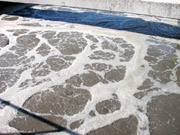The treatment of sewage using activated sludge
Activated sludge plants
 Activated sludge plants provide secondary treatment of sewage effluent using the principles of extended aeration. All systems have a two staged process.
Activated sludge plants provide secondary treatment of sewage effluent using the principles of extended aeration. All systems have a two staged process.
Activated sludge process
In the first stage the effluent is aerated which sets up a biochemical reaction. In the second stage of treatment separation occurs, using gravity sedimentation.
The two stages of the activated sludge system take place within interconnected tanks. This allows the mixed liquor to gravitate from the aeration tank to the settling tank and sludge to be recycled from the settling tank to the aeration tank.
Aeration
Within the aeration tank the effluent is supplied with oxygen and is mixed in the fine suspension of various micro-organisms. The organic material contained within the sewage effluent is oxidized and the biomass of micro-organisms grows.
Regulating the process
The biomass gets separated from the effluent in the settling tank and the thickened sludge is returned to the inlet of the aeration chamber. The effluent is then discharged from the final tank for further treatment or directly to a water course.
A small proportion of the recycled flow is removed from the system as surplus sludge. The amount of sludge removal is an important variable within the process, determining the average concentration of solids in the aeration tank and the overall rate of treatment.
Plant variants
Different styles of activated sludge plant are available. Compact plants feature two concentric tanks with the outer ring as the aeration tank which utilizes the principles of plug-flow, feeding to the inner settlement tank.
Sewerage Services
Sewerage Systems
Package Sewage and Wastewater Treatment Plant
Biological Filtration Secondary Treatment System
Rotating Biological Contactors
Biological Aerated Filter
Submerged Aerated Filters
The Treatment of Sewage using Activated Sludge
The Secondary Treatment of Sewage using a Sequencing Batch Reactor
Water Services >>

